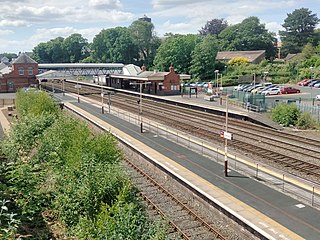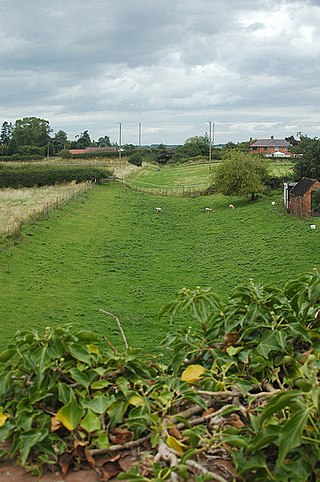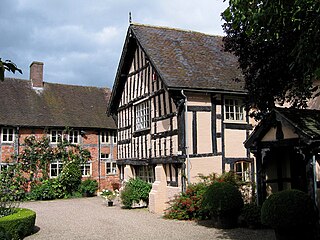
Market Drayton is a market town and civil parish on the banks of the River Tern in Shropshire, England. It is close to the Cheshire and Staffordshire borders. It is located between the towns of Whitchurch, Wem, Nantwich, Newcastle-under-Lyme, Newport and the city of Stoke on Trent. The town is on the Shropshire Union Canal and bypassed by the A53 road.

Woore is a village and civil parish in the north east of Shropshire, England. The population of the village as recorded in the 2011 census is 633, and for the civil parish is 1,069. The civil parish extends to about 3,950 acres.

The North Staffordshire Railway (NSR) was a British railway company formed in 1845 to promote a number of lines in the Staffordshire Potteries and surrounding areas in Staffordshire, Cheshire, Derbyshire and Shropshire.
The Potteries, Shrewsbury and North Wales Railway,, was a railway built between Shrewsbury, England, and quarry locations at Nantmawr and Criggion in Wales. It was initially opened in 1866; despite the extensive title it never reached further than those extremities. It had cost about £1.5 million to construct, but its financial performance was extremely poor, and economies resulted in near-suspension of maintenance, leading to dangerous conditions. The line rapidly became very run down as a result of low revenues and poor maintenance, and was closed at the instigation of the Board of Trade for safety reasons in June 1880. It lay derelict for 30 years but was revived when the Shropshire and Montgomeryshire Railway re-opened it as a light railway in 1911.

Hodnet is a village and civil parish in Shropshire, England. The town of Market Drayton lies 5.7 miles (9.2 km) north-east of the village.

The Shrewsbury and Birmingham Railway was authorised in 1846. It agreed to joint construction with others of the costly Wolverhampton to Birmingham section, the so-called Stour Valley Line. This work was dominated by the hostile London and North Western Railway, which used underhand and coercive tactics. The section between Shrewsbury and Wellington was also built jointly, in this case with the Shropshire Union Railway.

Wellington railway station serves the town of Wellington, Shropshire, England. It is situated on the former Great Western Railway's London Paddington to Birkenhead via Birmingham Snow Hill line. Trains are operated by West Midlands Railway, Avanti West Coast and Transport for Wales.

Nantwich railway station serves the town of Nantwich, Cheshire, England. It is on the Crewe to Shrewsbury line 4+1⁄2 miles (7.2 km) south west of Crewe. Opened in 1858, it was the junction for the Great Western Railway route to Wellington via Market Drayton until 1963.
The Wellington to Craven Arms Railway was formed by a group of railway companies that eventually joined the Great Western Railway family, and connected Wellington, Shropshire and Shifnal, with Coalbrookdale, Buildwas, Much Wenlock and a junction near Craven Arms. Its objectives were dominated by the iron, colliery and limestone industries around Coalbrookdale.

Audlem railway station was a station on the former Great Western Railway between Market Drayton and Nantwich, opened in 1863.
The Bishop's Castle Railway was a railway company that constructed a railway line in Shropshire, from near Craven Arms to Bishop's Castle. It opened in 1866 but was continuously short of money, and was unable to complete its originally-planned route, nor to provide more than the most basic level of equipment. It closed due to bankruptcy in 1935.
The Shrewsbury and Hereford Railway was an English railway company that built a standard gauge line between those places. It opened its main line in 1853.
Adderley railway station was a station serving the village of Adderley in the English county of Shropshire.
The Stoke to Market Drayton Line was a railway line that ran through Staffordshire and Shropshire that was built by the North Staffordshire Railway.

The Nantwich and Market Drayton Railway was a standard gauge railway line which began as a single line branch in the early 1860s and rapidly became part of the Great Western Railway's (GWR) double track Wellington to Nantwich Railway, which had through trains to Crewe. It carried through freight and local passenger traffic until its closure in the 1960s. Market Drayton was renowned for the manufacture of gingerbread, hence the line acquired the nickname the "Gingerbread Line".

The Wellington and Drayton Railway was a standard gauge line in Central England which carried through freight and local passenger traffic until closure in the 1960s. It was part of the Great Western Railway's double track Wellington-Crewe line, linking the Midlands to the north and northwest.

Wollerton is a small village within the civil parish of Hodnet in Shropshire, England. It lies approximately three miles to the south west of Market Drayton and sits on the old A53 and adjacent to the new Hodnet bypass which forms the new route of the A53.
Halmerend railway station is a disused railway station in Staffordshire, England.
Leycett railway station is a disused railway station in Staffordshire, England.
The Wellington to Nantwich Railway was a railway line that ran from the Wellington to Nantwich via Market Drayton. The line closed in 1967 to all traffic and the track was dismantled in 1970. The line also connected to the former Stoke-Market Drayton Line at Market Drayton which was a junction station for the line until the closure to Madeley Chord in 1956.












